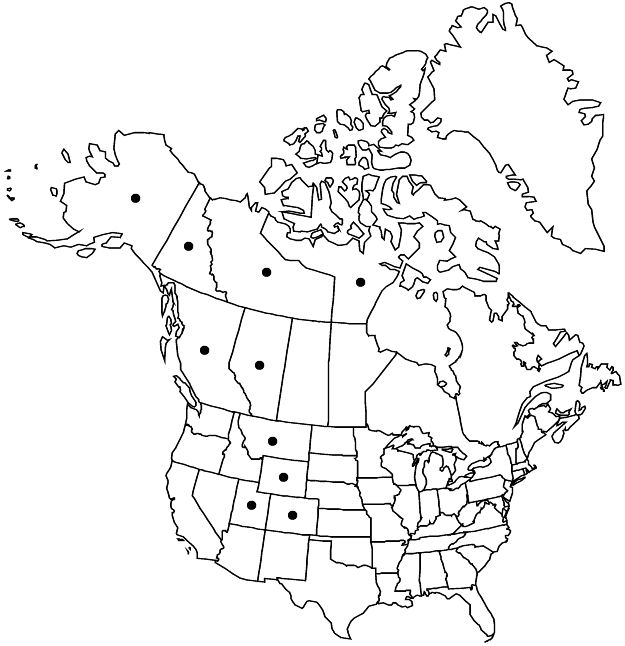Potentilla subgorodkovii
Bot. Zhurn. (Moscow & Leningrad) 78: 83. 1993.
Plants ± densely tufted. Caudex branches stout, usually columnar, sometimes sheathed with marcescent whole leaves. Stems erect, (0.2–) 0.3–1.5 (–2) dm, lengths 1.5–2.5 (–3.5) times basal leaves. Basal leaves (1–) 2–10 (–15) cm; petiole (0.5–) 1–5 (–12) cm, long hairs common to dense, ± ascending to loosely appressed, sometimes spreading, 1–2 mm, ± soft, smooth, crisped/short-cottony hairs usually sparse, sometimes absent or common, glands absent, sparse, or obscured; leaflets separate to slightly overlapping, central obovate or obtriangular, (0.5–) 1–2 (–3) × (0.4–) 0.8–1.5 (–2) cm, sessile or subsessile, base cuneate, margins revolute, distal (1/3–) 1/2–2/3 (–3/4) incised 1/2–2/3 (–3/4) to midvein, teeth 2–3 (–4) per side, usually ± distant, surfaces somewhat to more often strongly dissimilar, abaxial yellowish or grayish white to white, long hairs 0.8–1.5 mm, cottony-crisped hairs ± dense, adaxial green to grayish green, long hairs sparse to ± abundant, other hairs usually absent. Cauline leaves (0–) 1 (–2). Inflorescences usually 1 (–2) -flowered, rarely to 5-flowered. Pedicels (0.5–) 2–4 cm in flower, to 5 cm in fruit. Flowers: epicalyx bractlets elliptic-lanceolate to ovate, (3–) 4–6 (–7) × (0.8–) 1.2–2 (–2.5) mm, (1/2–) 2/3 to as wide as sepals, margins revolute, rarely flat, red-glands absent; hypanthium 2.5–4 mm diam.; sepals 4–6 (–7) mm, apex subacute; petals (5–) 6–9 × (5–) 7–9 mm, significantly longer than sepals; filaments 1–1.3 mm, anthers 0.4–0.6 mm; carpels 30–40, apical hairs absent, styles narrowly columnar to conic-tapered, papillate-swollen on proximal 1/5 (–1/3), 0.9–1.1 mm. Achenes 1.2–2 mm. 2n = 28, 42, 49, 56 (Russian Far East).
Phenology: Flowering late spring to summer.
Habitat: Dry alpine heaths, exposed ridges and summits, rock outcrops, scree and talus, dry tundra, acidic and calcareous bedrock
Elevation: 0–4300 m
Distribution

Alta., B.C., N.W.T., Nunavut, Yukon, Alaska, Colo., Mont., Utah, Wyo., Asia (Russian Far East), Asia (Sakha [Yakutia])
Discussion
The name Potentilla subgorodkovii was coined for a presumed hybrid species resulting from P. crebridens × P. subvahliana; here it is applied in a collective meaning for plants combining characteristics from multiple species of the P. uniflora/villosa and P. nivea groups. Morphologically, this collective entity is much closer to the P. uniflora/villosa group than to the P. nivea group and is clearly different from primary hybrids and clones, which are often observed.
Potentilla subgorodkovii constitutes about half of what previously has been considered P. uniflora in Alaska and Yukon and is the only such entity fully confirmed south of northern British Columbia. These southern populations occur outside the range of possible parental members of the P. uniflora/villosa group and do not support the hybrid hypothesis. They may instead represent a distinct species, not yet described.
Selected References
None.
Lower Taxa
"thin" is not a number."dm" is not declared as a valid unit of measurement for this property."-2.5(-3.5)timesbasalleaves" is not declared as a valid unit of measurement for this property."dm" is not declared as a valid unit of measurement for this property."dm" is not declared as a valid unit of measurement for this property.